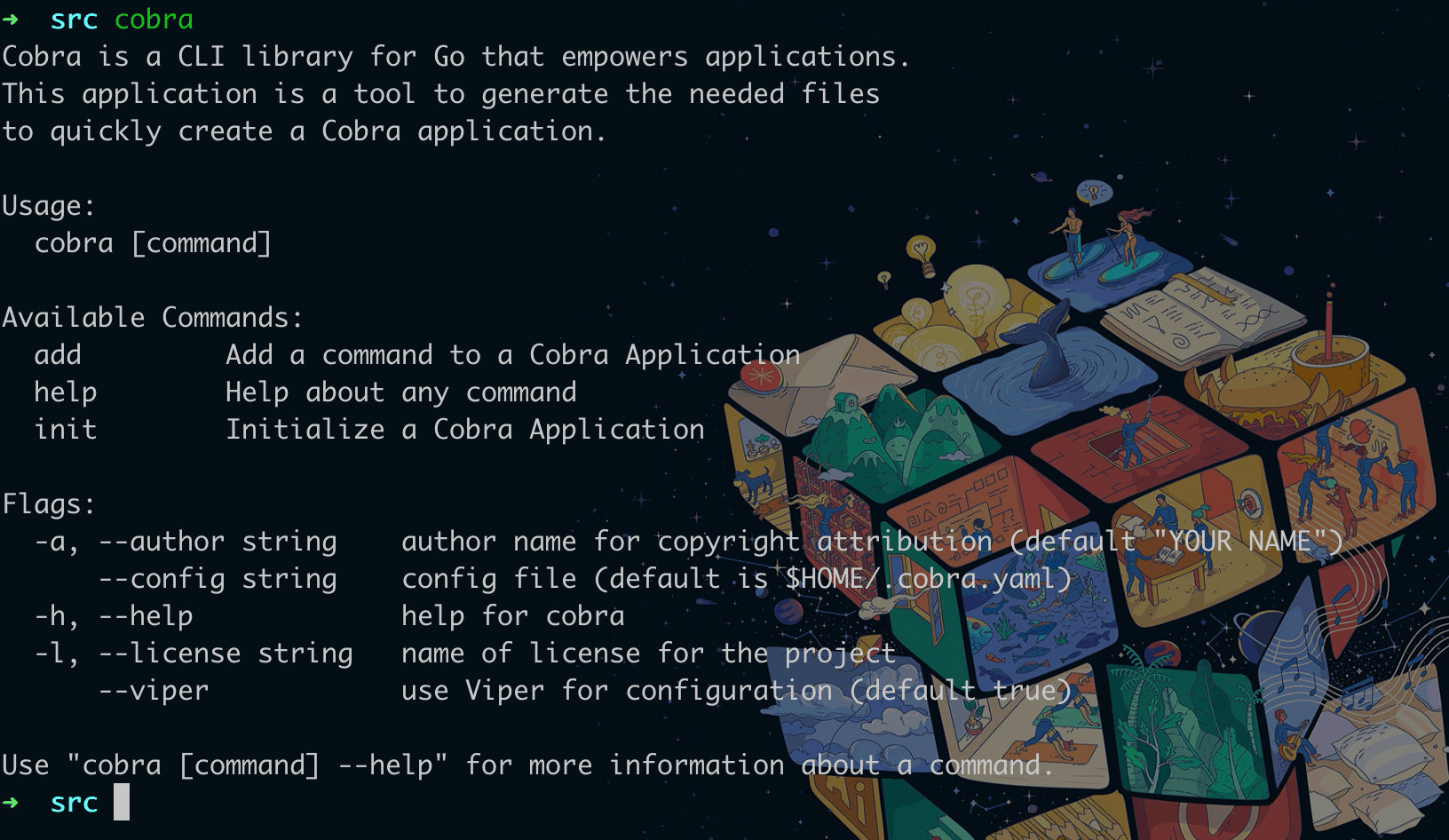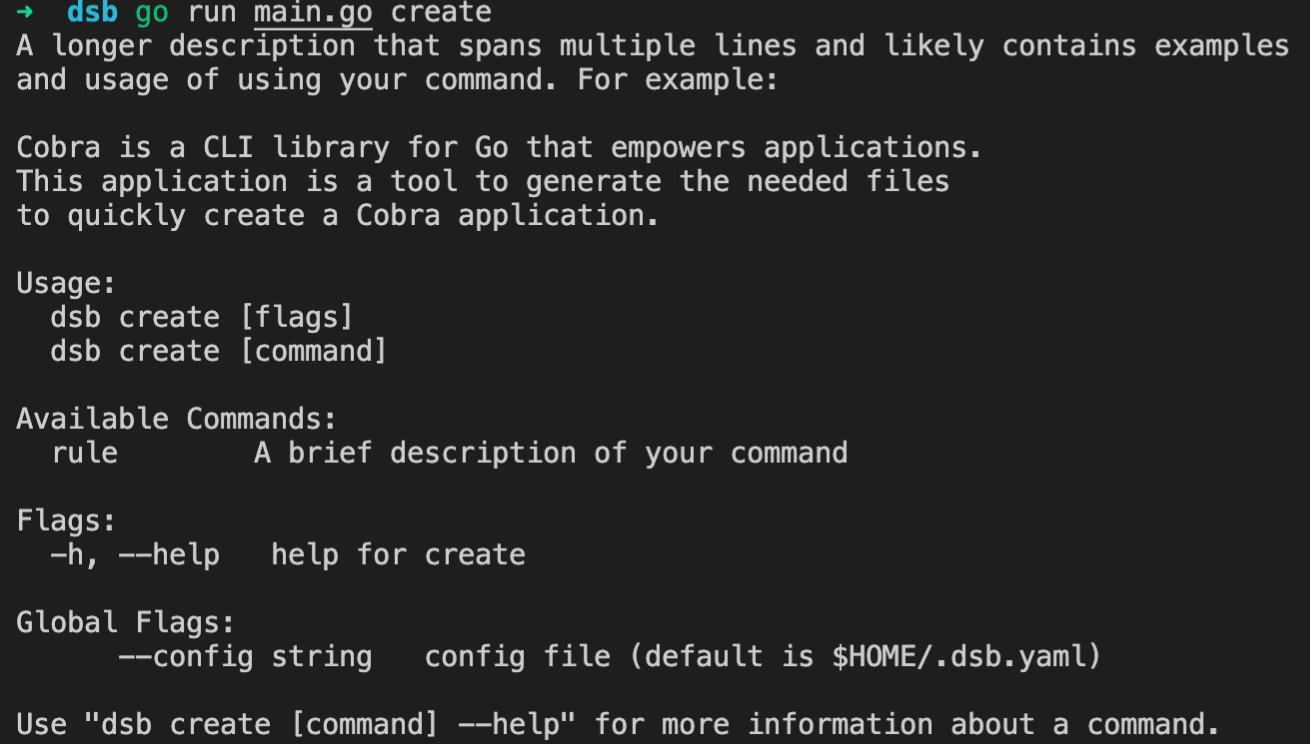Cobra既是用于创建强大的现代CLI应用程序的库,也是用于生成应用程序和命令文件的程序。
有多强呢,我列举一下优秀的开源项目中用到Cobra的
1 2 3 4 5 6 7 8 9 10 11 12 13 14 15 16 17 Kubernetesformer Docker)distribution )enterprise )
概念介绍 Cobra 结构由三部分组成:命令 (commands)、参数 (arguments)、标志 (flags)。基本模型如下:APPNAME VERB NOUN --ADJECTIVE 或者 APPNAME COMMAND ARG --FLAG
hugo:根命令
再看个带有参数的例子:
git:根命令
总结如下:
commands 代表行为,是应用的中心点
主要功能 cobra 的主要功能如下,可以说每一项都很实用:
简易的子命令行模式,如 app server, app fetch 等等add cmdname
上面的描述稍微有点抽象,下面结合例子讲下cobra如何做的。
Cobra的安装 首先,通过go get下载cobra
go get -v github.com /spf13/cobra/cobrago install
初始化项目 在命令行下运行下cobra命令
➜ src cobra init dsb is ready at
当前目录结构为
dsb cmd root .go LICENSE main .go
可以看到初始化后的项目非常简单,主要是 main.go 和 root.go 文件。在编写代码之前,我们先分析下目前代码的逻辑。
代码分析 先查看下入口文件 main.go。代码逻辑很简单,就是调用 cmd 包里 Execute()函数:
package mainimport "demo/cmd" func main ()
再看下 root.go 中 rootCmd 的字段:
1 2 3 4 5 6 7 8 9 10 11 12 13 14 15 16 17 18 19 20 21 22 23 24 25 26 ...var rootCmd = &cobra.Command{Use : "demo" ,"A brief description of your application" ,For example:CLI library for Go that empowers applications.generate the needed filesif err := rootCmd.Execute(); err != nil {err )Exit (1)
简单说明:
Command 结构体中的字段当然远不止这些,受限于篇幅,这里无法全部介绍。有兴趣的童鞋可以查阅下官方文档。
运行测试:
[root@localhost demo]# go run main.goand likely containsand usage of using your application. For example:for Go that empowers applications. tool to generate the needed filesto quickly create a Cobra application.
如果运行的结果和我的一致,那我们就可以进入到实践环节了。
实践 子命令 之前运行会提示 subcommand is required,是因为根命令无法直接运行。那我们就添加个子命令试试。
当前项目结构为:
...func init () {
运行测试:
[root@localhost demo]create calledError : unknown command "crea" for "demo" create 'demo --help' for usage.unknown command "crea" for "demo" create
子命令嵌套 对于功能相对复杂的 CLI,通常会通过多级子命令,即:子命令嵌套的方式进行描述,那么该如何实现呢?
首先添加子命令 rule :
[root@localhost dsb]/root/g o/src/ dsb
当前目录结构如下:
dsb cmd create .go root .go rule .go LICENSE main .go
目前create 和 rule 是同级的,所以需要修改 rule.go 的 init() 来改变子命令间的层级关系
...func init ()
这样 rule 就属于create的子命令了。
...var createCmd = &cobra.Command{"create" ,"create" ,"Create Command." ,func (cmd *cobra.Command, args []string ) if len (args) == 0 {return
运行测试:
直接运行 create,打印帮助提示:
运行 create rule,输出 rule called:
[root@localhost dsb]# go run main.go create rule rule called
参数 先说说参数。现在有个需求:给 CLI 加个位置参数,要求参数有且仅有一个。这个需求我们要如何实现呢?
实现前先说下,Command 结构体中有个 Args 的字段,接受类型为 type PositionalArgs func(cmd *Command, args []string) error
内置的验证方法如下:
NoArgs:如果有任何参数,命令行将会报错
由于需求里要求参数有且仅有一个,想想应该用哪个内置验证方法呢? ExactArgs(int)。rule.go:
...&cobra .Command{ Use: "rule" , Short: "rule" , Long: "Rule Command." , Args: cobra.ExactArgs(1 ), Run: func(cmd *cobra.Command, args []string) { "Create rule %s success.\n" , args[0 ])
运行测试:
不输入参数:
[root@localhost dsb]# go run main.go create ruleError: accepts 1 arg(s), received 0
输入 1 个参数:
[root@localhost dsb]# go run main.go create rule fooCreate rule foo success.
输入 2 个参数:
[root@localhost dsb]# go run main.go create ruleError: accepts 1 arg(s), received 2
从测试的情况看,运行的结果符合我们的预期。如果需要对参数进行复杂的验证,还可以自定义 Args,这里就不多做赘述了。
标志 再说说标志。现在要求 CLI 不接受参数,而是通过标志 –name 对 rule 进行描述。这个又该如何实现?
Cobra 中有两种标志:持久标志 ( Persistent Flags ) 和 本地标志 ( Local Flags ) 。
持久标志:指所有的 commands 都可以使用该标志。比如:–verbose ,–namespace
这个标志的作用是修饰和描述 rule的名字,所以选用本地标志。修改 rule.go:
1 2 3 4 5 6 7 8 9 10 11 12 13 14 15 16 17 18 19 20 21 22 23 24 25 26 27 28 package cmdimport ("fmt" "github.com/spf13/cobra" var name string var ruleCmd = &cobra.Command{"rule" ,"rule" ,"Rule Command." ,func (cmd *cobra.Command, args []string ) if len (name) == 0 {return "Create rule %s success.\n" , name)func init () "name" , "n" , "" , "rule name" )
说明:StringVarP 用来接收类型为字符串变量的标志。相较StringVar, StringVarP 支持标志短写。以我们的 CLI 为例:在指定标志时可以用 --name,也可以使用短写 -n。
运行测试:
# 这几种写法都可以执行create rule -n fooCreate rule foo success.create rule Create rule foo success.create -n foo rule Create rule foo success.
读取配置 需求:要求 –name 标志存在默认值,且该值是可配置的。
很多情况下,CLI 是需要读取配置信息的,比如 kubectl 的~/.kube/config。在帮助提示里可以看到默认的配置文件为 $HOME/.demo.yaml:
Global Flags: config file (default is $HOME /.demo.yaml)
配置库我们可以使用 Viper。Viper 是 Cobra 集成的配置文件读取库,支持 YAML,JSON, TOML, HCL 等格式的配置。
添加配置文件 $HOME/.demo.yaml,增加 name 字段:
[root@localhost ~]name : xiangli
修改 rule.go:
1 2 3 4 5 6 7 8 9 10 11 12 13 14 15 16 17 18 19 20 21 22 23 24 25 26 27 28 29 30 31 32 33 package cmdimport ("fmt" "github.com/spf13/viper" "github.com/spf13/cobra" var name string var ruleCmd = &cobra.Command{"rule" ,"rule" ,"Rule Command." ,func (cmd *cobra.Command, args []string ) if len (name) == 0 {"name" )if len (name) == 0 {return "Create rule %s success.\n" , name)func init () "name" , "n" , "" , "rule name" )
运行测试:
[root@localhost dsb]# go run main.go create rule config file: /root/.demo.yaml
如果 CLI 没有用到配置文件,可以在初始化项目的时候关闭 Viper 的选项以减少编译后文件的体积,如下:
cobra init demo --pkg-name =demo --viper =false
编译运行 编译生成命令行工具
[root@localhost dsb]# go build -o dsb
运行测试:
[root@localhost dsb]# ./dsb create rule config file: /root/.demo.yaml
学起来啊,同学们。



